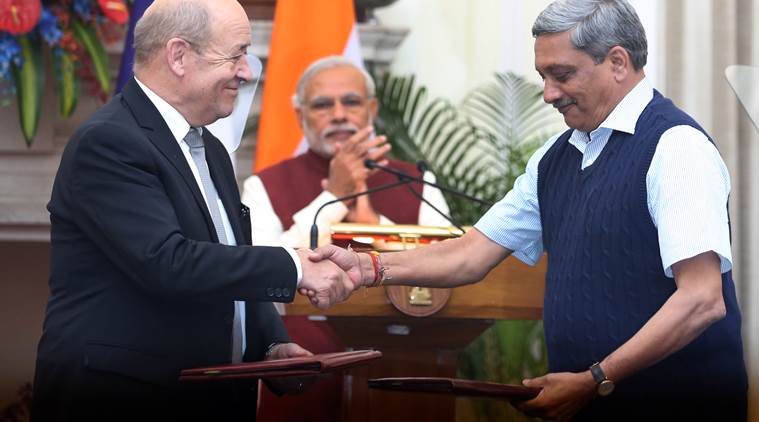Rafale deal is good, but bigger challenges for IAF remain
Mangalore Today News Network
Sep 24, 2016: When the Prime Minister of a country personally announces a deal for a fighter aircraft in a foreign land, there can be no doubt that the deal will eventually be signed. That there were still doubts about the fate of the Rafale deal – suddenly announced by PM Narendra Modi in Paris in April last year – is a testimony to the level of confidence we have on our defence procurement system.

But 17 months down the line, and for Rs 59,000 crore, the deal is finally done. India gets 36 Rafale fighters, the first one within 36 months and the entire complement within 67 months. There is no clause for a follow-up deal – usual practise is for 50 per cent of the contracted quantity to be bought on terms of the original contract — which means that if India wants to buy more Rafales, it will have to enter into a fresh negotiation with France.
A fresh negotiation is always a scary proposition as seen from the Rafale deal itself. The IAF first mooted the idea in 2000 for new fighter aircraft to replace the MiGs, which were to go out of service, till HAL made the indigenous Tejas. The tender issued in 2007 was for 126 aircraft, and that number is important: 126 fighters mean eight squadrons.
IAF wants 45 fighter squadrons to ward off a two-front collusive threat, and it is authrorised 42 squadrons. It currently has only 32, and the airworthiness and vintage of fighters in these squadrons is not satisfactory. IAF told the parliamentary standing committee that at this rate, it will be down to 25 squadrons by 2022. That is a scary scenario.
Two squadrons of Rafale will do little to avert that crisis, and now that the much-hyped deal is out of the way, the defence minister ought to focus on making up these shortages. He has put all his weight behind the Tejas but it is an unproven fighter, with production facilities still not in place. Beyond the first squadron, there is no guarantee about induction of Tejas fighters.
Meanwhile, SAAB, Boeing and Lockheed Martin have submitted their proposals for respectively making the Gripen, F-18 and F-16 in India. Reports suggest that their proposals are being evaluated by the IAF and the ministry. There is no idea as to when any of these proposals will be approved and when their first aircraft will be made available to India. But the IAF squadron strength will continue to deplete with every passing year.
Rafale is not a bad deal for India. IAF needed an aircraft for the nuclear strike role to replace the French Mirages and Rafale is the best option. By all yardsticks, we negotiated hard to get the best possible price. It is understandable then that the Indian side would have popped the bubbly for the Rafale deal. But let us put an end to the celebrations, and focus on the real task ahead: building up the IAF to an adequate strength.
- Dakshina Kannada, Udupi sees voter turnout of nearly 72% till 5 pm
- Mangaluru International Airport initiates work on precision approach lighting system
- Sandalwood star Rakshit Shetty casts his vote in Udupi, Watch
- Brisk polling across Dakshina Kannada constituency
- Ashta Mutt pontiffs cast vote in Udupi
- Udupi: Candidates Jayaprakash Hegde, Kota Srinivas Poojary exercise franchise
- Vittal: EVM technical glitch delays voting at Karopady booth
- Orange alert: Karnataka State Disaster Management cell gives animated advisory
- Lok Sabha elections 2024: Voting underway in 14 constituencies in Karnataka
- Mangaluru: Activists clash with media, police at Capitanio
- Karnataka Lok Sabha election: Voting timings, Key candidates and phase 2 polling constituencies
- Sullia: Rider dies in bike-jeep collision
- Mangaluru: Mustering process held ahead of LS polls
- LS elections 2024: Left rattled by allegations of CPI(M) veteran’s plans to join BJP
- Tejasvi Surya booked for ’seeking votes in the name of religion’ on polling day
- ‘He will shed tears’: Rahul Gandhi’s sharp attack on PM Narendra Modi
- Lok Sabha elections: 4 men collapse and die amid Phase 2 voting in Kerala
- BJP becomes first Indian party to cross Rs 100 crore ad spend on Google
- 78 year old woman, on oxygen support, casts vote in Bengaluru
- Long queues outside Bengaluru hotel for free Benne Dosa, Ghee Laddu on polling day, Watch
- What happens if NOTA gets maximum votes? Supreme Court notice to poll body
- BJP candidate K Sudhakar booked for ’Bribery’ in Karnataka, Rs 4.8 Cr cash seized
- 2 Terrorists dead, 2 army personnel injured as gunbattle resumes in J&K’s Baramulla
- Richest candidate in phase 2 has Rs 622 crore assets, poorest just Rs 500
- PM Modi says your vote is your voice, calls for polling in record numbers
- New residential complex for the judges inaugurated in Mangaluru
- Absconding accused nabbed after 8 years
- Truck with cylinders turns turtle in Beltangady
- Bhoota Kola artist dies of cardiac arrest
- Development of the country should be our goal: Ganesh Karnik
- Container truck gets stuck under Modankap railway bridge
- Truck crushes bike’s pillion rider near BC Road
- Head constable dies of heart attack
- Udupi: PDO dismissed over financial irregularities
- CREDAI to resume Skill Development Program for Construction Workers in Mangaluru
- John B Monteiro elected president of Rachana Catholic Chamber of Commerce & Industry
- Sudhanshu Rai elected district president of All College Student Association
- Chief Minister to visit Mangaluru, Udupi on August 1
- Nitte University awards PhD degree to Tina Sheetal D’Souza
- Sachitha Nandagopal honoured by CMTAI for Community Service
- CITY INFORMATION
- TRAVEL
- TOURIST INFORMATION
- HEALTH CARE
- MISCELLANEOUS




 Write Comment
Write Comment E-Mail To a Friend
E-Mail To a Friend Facebook
Facebook Twitter
Twitter  Print
Print 

